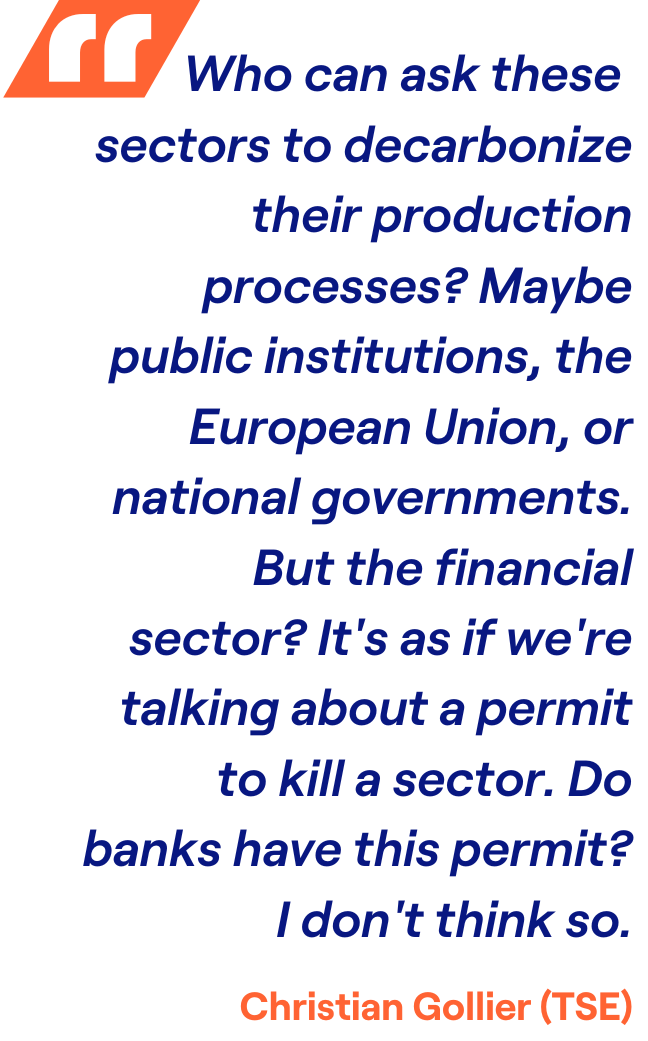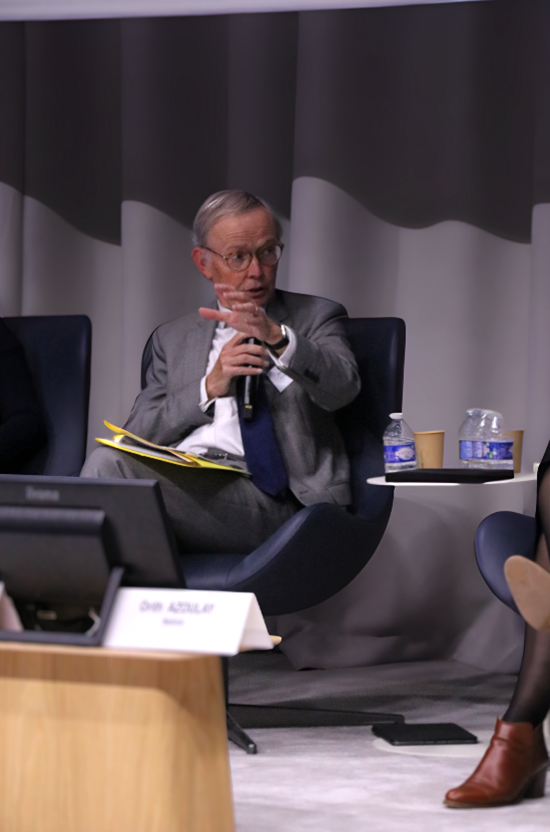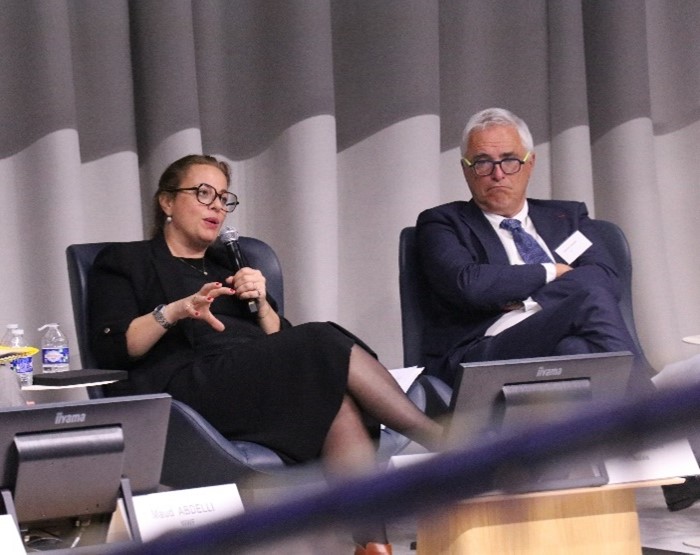Organized by Banque de France and TSE in Paris, the Climate & Biodiversity Conference on May 22-23 focused on the impact of environmental risk and ecological destruction on financial stability and monetary policy. Speakers from world-class research centers, central banks, regulatory bodies, finance institutions, non-profit institutions, and the industrial sector covered topics such as financing the green transition, the consideration of nature and climate in financial stability, macroeconomic modelling of climate change and green deflation, and nature modelling.
The first day ended with a roundtable discussion on Monetary Policy & Climate, featuring decision-makers and leading experts on economics, finance, and the environment.

 Alexandre Garabedian (Managing Director, AGEFI) opened the discussion by asking the speakers for their perspectives on the climate and biodiversity challenges facing the financial system.
Alexandre Garabedian (Managing Director, AGEFI) opened the discussion by asking the speakers for their perspectives on the climate and biodiversity challenges facing the financial system.
Christian Gollier (TSE Director) identified three key challenges: the capital costs of the energy transition; legitimacy in decision-making; and the political will to get things moving. Steel, for example, contributes 8% of world greenhouse gas emissions. However, as a capital-intensive sector with long investment cycles in a highly competitive market, it cannot bear the huge costs of transition without seeing its competitiveness drastically reduced, with a clear solvency issue. To lead a radical transformation of this sector requires legitimacy and knowledge of the risks involved. “Who can ask these sectors to decarbonize their production processes? Maybe public institutions, the European Union, or national governments. But the financial sector? It's as if we're talking about a permit to kill a sector. Do banks have this permit? I don't think so.”
Given the urgent need to find the funds for this transition, Maud Abdelli (Greening Financial Regulation Initiative, WWF) believes the main challenges for the financial system lie in the link between climate change and biodiversity loss. Is there an understanding of the real dynamics between these two natural issues? How should risk be considered and calculated? Can actions be implemented that will have an impact in the short term?
Mathieu Lefebvre (CEO, Waga Energy) explained that his company is dedicated to reducing methane emissions and recovering biogas from waste storage. He confirmed that the biggest challenge in the transition to renewable energy is to prioritize access to financing. For this to happen, investors must display greater tolerance toward credit risk and offer stronger support for green technologies.
 Private investors cannot bear the entire burden, the panel’s experts agreed, insisting that the energy transition must also be supported by the monetary policies of central banks. Olivier Garnier (Director General, Banque de France) underlined that central banks have a role to play, although climate change mitigation policies are primarily the responsibility of governments Monetary policy tools need to be updated to take account of the growing risks to price and financial stability posed by the climate transition. “Economists used to consider climate change as a distant threat arriving by the end of the century. Now, we must integrate this kind of problematic in our modelling, in our projections, and the time horizon has shortened.” Such efforts were boosted by the creation of the Network for the Greening of the Financial System (NGFS) in 2017, a global exchange forum on best practices for enhancing sustainable finance tools. Banque de France is also considering a “Climate Index” to assess all companies’ performance on a range of factors, including the transition trajectory and the exposure to physical risks. At the same time, monetary policymakers need to address the evaluation of transition policies and their macroeconomic impact, as well as the integration of climate risk into policy design.
Private investors cannot bear the entire burden, the panel’s experts agreed, insisting that the energy transition must also be supported by the monetary policies of central banks. Olivier Garnier (Director General, Banque de France) underlined that central banks have a role to play, although climate change mitigation policies are primarily the responsibility of governments Monetary policy tools need to be updated to take account of the growing risks to price and financial stability posed by the climate transition. “Economists used to consider climate change as a distant threat arriving by the end of the century. Now, we must integrate this kind of problematic in our modelling, in our projections, and the time horizon has shortened.” Such efforts were boosted by the creation of the Network for the Greening of the Financial System (NGFS) in 2017, a global exchange forum on best practices for enhancing sustainable finance tools. Banque de France is also considering a “Climate Index” to assess all companies’ performance on a range of factors, including the transition trajectory and the exposure to physical risks. At the same time, monetary policymakers need to address the evaluation of transition policies and their macroeconomic impact, as well as the integration of climate risk into policy design.
Financial systems must focus on the drivers of nature loss, said Maud Abdelli, which include invasive species, damaging land use, climate change, over-exploitation of natural resources, and pollution. To have an immediate impact, certain sectors should be prioritized, and special policies set up to support them. For example, new regulation of the European market aims to prohibit the sale or export of products that have contributed to deforestation or forest degradation.
To implement good practices, she added, firms must understand their impact on nature and biodiversity and how much they depend on healthy ecosystems. Despite the lack of a universal biodiversity indicator, data is available to help everyone contribute to climate and biodiversity efforts. Central banks and financial regulators already have tools to measure biodiversity footprints and financial risk linked to nature loss. They must use these tools to help companies in high-impact sectors to adapt their business models, notably to protect against deforestation, freshwater scarcity, and destruction of marine ecosystems.
 Orith Azoulay (Global Head of Green and Sustainable Finance, Natixis CIB) discussed how banks can improve their impact on the environment. Since 2019, Natixis has used an internal capital allocation mechanism to modulate the profitability of loans according to their expected climate impact. As its former CEO used to say, the aim is to send the right signal “to get brown to pay for green”; that is, so that polluters facilitate green financing. Based on seven pre-defined levels of environmental impact, the bank applies a different credit risk measurement rate. According to Orith, its balance sheet has improved in favor of green investments by 10% in three years. This shows that without applying a carbon exclusion policy, but simply by better managing its budget, a bank can improve its best practices and reduce its footprint.
Orith Azoulay (Global Head of Green and Sustainable Finance, Natixis CIB) discussed how banks can improve their impact on the environment. Since 2019, Natixis has used an internal capital allocation mechanism to modulate the profitability of loans according to their expected climate impact. As its former CEO used to say, the aim is to send the right signal “to get brown to pay for green”; that is, so that polluters facilitate green financing. Based on seven pre-defined levels of environmental impact, the bank applies a different credit risk measurement rate. According to Orith, its balance sheet has improved in favor of green investments by 10% in three years. This shows that without applying a carbon exclusion policy, but simply by better managing its budget, a bank can improve its best practices and reduce its footprint.
Is the European Union on the right path? In addition to increasing oil and natural gas production, the USA is investing aggressively in wind, solar and bioenergy. At the same time, investment programs aimed at reducing inflation (IRA), boosting local semiconductor production (CHIPS Act), infrastructure and employment, are helping to revitalize its industry. This balanced approach can allow a smooth transition, noted Mathieu Lefebvre, by mitigating the risks of energy dependence while maintaining a highly competitive industrial sector.
Europe lacks the resources and production to follow the US strategy, he argued. The economic consequences of the decline of European manufacturing and heavy industry are exacerbated by energy dependence, ambitious environmental targets and a difficult transition to renewable energies. Reducing resource intensity on the demand side is therefore essential for the EU, unlike the resource-rich USA. The central bank's mission of providing stability to the financial system must be fulfilled regarding climate change, while also considering the idea of specializing in energy resources.
Published in TSE Reflect, June 2024
See also: conference page and TSE-Banque de France partnership page
